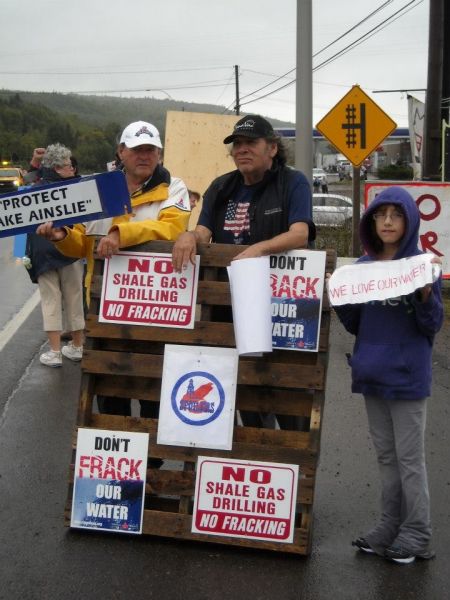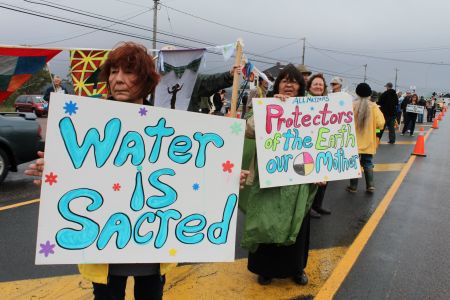NOEL, NS — Even in gung-ho, frack everything, Pennsylvannia, with its tens of thousands of fracked wells, at least the pollution from the billions of litres of fluid wastes is treated as a serious issue.
In Nova Scotia we have yet to hear whether the Nova Scotia Environment Department (NSE) has any idea what became of the first four million-plus litres of fluid waste to come from Triangle Petroleum's two fracked wells near the town of Kennetcook. NSE simply notes that they were disposed of somewhere, by somebody.
From the author’s investigations, indications are that Atlantic Industrial Services (AIS), the waste water treatment company located in Debert, NS, was not the disposal contractor; but they have handled all fracking wastes coming from Kennetcook and beyond since that time. A fair bit of this has made the mainstream news; from bringing New Brunswick wastes to Nova Scotia, to the currently proposed processing for the radioactive material that has been found in the Kennetcook frack waste ponds. But there is more than meets the eye.
AIS started looking at the business opportunity of treating fracking wastes in 2007 — the early days of Triangle Petroleum’s shale gas fracking venture in Hants County. Hydraulic fracturing wastes are classified as a Transported Dangerous Good (TDG) under the federal act of that name. There was no approved processor of TDGs anywhere in the region, requiring all such wastes to be shipped at least as far as Quebec for disposal. This is likely a major reason why the unaccounted for four million litres appear to have just ‘slipped away’... and why NSE declines to look into what happened.
Atlantic Industrial Services proposed a substantial expansion of their Debert waste water treatment facility so that they could become an approved processor of TDGs. The company received Ministerial approval in September 2009 to proceed with construction at the Debert facility.
By 2011, AIS had acquired the reputation of being the region’s only facility approved for processing fracking wastes. Lobbyist for the Canadian Association of Petroleum Producers, Angie Leonard was quoted as saying: “Current procedure is that any waste water is put into trucks and shipped to Debert, Nova Scotia, to an accredited waste water facility where it's treated.”
Presentations made to Colchester County Council about the proposed processing of the Kennetcook wastes at the Debert facility always refer to the experimental project for filtering out the radioactive material that was recently revealed to have further contaminated the fluid wastes resulting from Triangle's failed fracking attempts. After this, the waste waters will go through the Debert facility’s “normal process.” But what exactly is this normal process already in place?
While the Environmental Assessment for the Debert facility expansion was under consideration, AIS approached the Town of Windsor about disposing of the Kennetcook frack wastes at its sewage treatment plant. With no concern shown for the virtually universal criticism of putting untreated fracking wastes into municipal sewage, Nova Scotia Environment granted an Industrial Approval in September 2009 — the same time as AIS got the Ministerial go-ahead for its facility expansion required for treating fracking wastes.
AIS has not turned a shovel since getting approval for construction of their proposed Debert expansion. The two-year deadline and a one-year extension for completing the project have expired. Yet we know of at least 7.3 million litres of untreated fracking wastes that AIS discharged into the Windsor Sewage Treatment Plant in 2010 and 2011. With an approval to do so, but without their own expanded facility to treat the waste, AIS simply turned to the Town of Windsor's sewage system to fill this void.
There is also the question of where those 7.3 million litres came from. They were presented to the Town of Windsor as coming from the Kennetcook ponds. NSE obviously expected the approval to be used to empty the Kennetcook frack waste ponds. But those ponds were still full in 2011, and it is mathematically impossible that 7.3 million litres could have been taken from the Kennetcook waste ponds during the time of the discharges. Only a small amount of the wastes — if any — could have come from Kennetcook.
During that same time period, AIS brought that much fluid fracking wastes to Nova Scotia from New Brunswick. Everyone at the time — this author included — thought those wastes were treated and discharged at the Debert facility. But we now know that AIS did not have approval to treat waste dangerous goods at Debert, and Colchester County, which would have seen treated wastes at Debert flow through their sewer system, says that no treated fracking wastes have been discharged by AIS into their system.
The manner that NSE wrote the approval for discharge at the Windsor sewage treatment plant was in effect a blank check for AIS to bring untreated fracking wastes from anywhere. AIS was not required to report their shipments to Environment, and it has already been established that Environment did not see any reason to initiate monitoring on fracking waste disposal.
While the Town of Windsor stopped taking fracking wastes in August 2011, it is murky as to how NSE even set that measure in motion. Also, despite AIS having not upgraded its facilities to process waste dangerous goods, they brought New Brunswick wastes to the Debert facility, where they appear to still be in storage lagoons.
More puzzling still is how NSE could, in 2011, be actively engaged in allowing AIS to transport and process the wastes from the Kennetcook ponds — one month after the department granted AIS approval to defer for a third year the construction that would enable them to become an approved processor. That draining, transporting, and planned processing of the Kennetcook waste ponds was suspended in November 2011 after the belated finding of elevated radioactivity in the wastes. One third of the wastes had come to the Debert AIS facility, with the rest remaining at the Kennetcook ponds.
Since September 2012, the public has known of the AIS proposal to use an experimental process to filter out the radioactive material, after which the wastes are proposed to go through the Debert facility’s “normal process” for fracking wastes. It would appear however, that there is no normal process to speak of.
Atlantic Industrial Services is not a processor of fracking wastes; instead it is acting as a broker. First they arranged to dispose of untreated wastes at the Windor sewage treatment plant. When that option was removed from them, they stored the wastes in lagoons at their Debert facility, even though they have never been approved to process TDGs.
Maybe there is some kind of processing of fracking wastes that goes on at AIS's Debert facility. And maybe NSE has even bestowed some kind of bureaucratic fig leaf on AIS for such processing, lowering the environmental protection bar that AIS has to clear. More likely, following earlier practice of eschewing inquiries that might lead to inconvenient conclusions, as with the unaccounted-for four million litres-plus, the department has decided to abdicate their regulatory monitoring role to passively stand behind the language of the TDG Act, which puts onto AIS the legal responsibility for determining what is a dangerous good.
One thing is certain. Even oil and gas industry associations accept that fracking wastes are a TDG. In its Environmental Assesment submission AIS accepts that processing oil and gas drilling wastes requires meeting regulatory standards for processing TDGs. Every amendment of their operating Industrial Approval from NSE since 2009 explicitly reaffirms that the facility cannot process TDGs. Nor have they begun any of the expansion and construction which was approved.
Despite all this, AIS has been allowed by NSE, even facilitated, in the disposal and inconclusive storage of fracking wastes. And outright alarming is the approval by the regulator we depend on letting AIS ‘graduate’ from the twilight zone of this pseudo-processing, to the big leagues of concentrating radioactive material as it is removed from the Kennetcook fracking wastes. The frack waste pits in Kennetcook and at the Debert AIS facility have homes and domestic water wells within several hundred metres. With the approval of Environment, AIS has been experimenting on the third of the waste total that is in Debert, the plan being to do the rest of it on site at the Kennetcook waste ponds.




